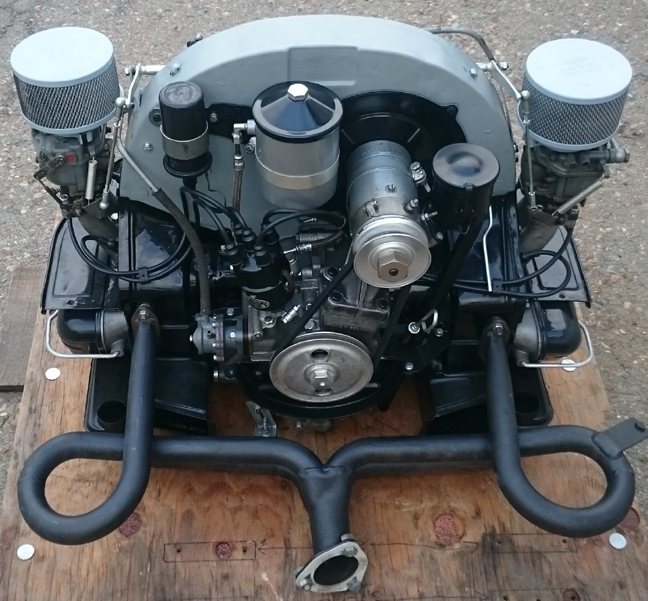Copyright © 2007 - 2026, Coachworks For contact data Click Here.

Copyright © 2007 - 2026
Copyright © 2007 - 2026,
Coachworks For contact data
Click Here.

While none of the following is wrong, we've found that U-Line has an inexpensive crate available that's perfect for our engines for less than $200. It's a 36" cube and works great! Here's a link straight to the specific crate.
Shipping for us primarily involves engines, since shipping whole cars is a commodity affair. We've loaded and shipped whole containers full of cars, but if you want that, you need to talk with us directly. Meanwhile, if you have just one car to ship to us, or for us to ship to you, if you're close, we'll do it ourselves, or if farther afield, we'll use a standard carrier.
![]()
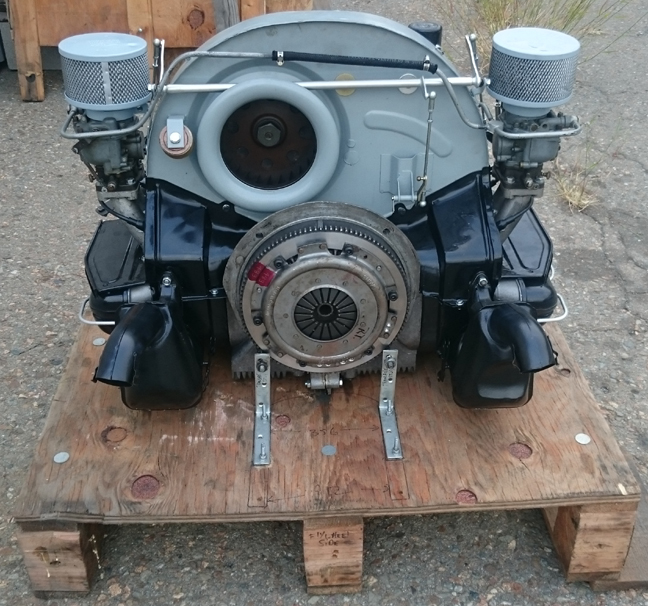 We've
shipped engines pretty much literally all over the globe, though surely there
are countries we've not yet shipped to, and we've shipped a handful of transaxles
around, too. ...In our experience, the most important feature is the shipping
crate, and second most important, the shipping insurance! That said, here are
the issues the customer needs to consider.
We've
shipped engines pretty much literally all over the globe, though surely there
are countries we've not yet shipped to, and we've shipped a handful of transaxles
around, too. ...In our experience, the most important feature is the shipping
crate, and second most important, the shipping insurance! That said, here are
the issues the customer needs to consider.
AT RIGHT: One of our engines about to be returned to our customer in our custom made crate. Note the ink markings near the brackets that that show customers how to fit either a 356 or 912 engine perfectly.
There's more on all these points below:
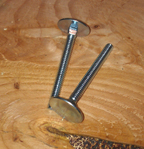 All
Bolt Lengths Must Go INTO The Crate! In particular NOTHING can be
in the way of forklift tines or a pallet jack, and a bolt sticking
out on the side or top is a safety issue.
All
Bolt Lengths Must Go INTO The Crate! In particular NOTHING can be
in the way of forklift tines or a pallet jack, and a bolt sticking
out on the side or top is a safety issue.
BELOW RIGHT: Our re-usable crate, all sealed up. Note how the 1/2" sides are doubled by three verticals on two opposing sides.
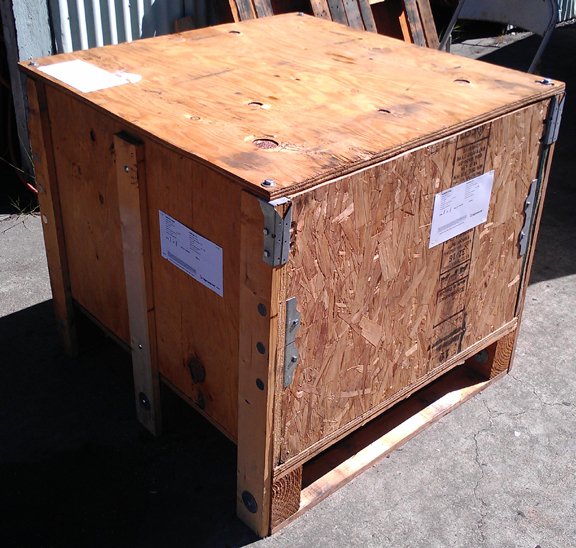 The
crate protects the contents and in the shipping industry it's considered a consumable.
That is, if they damage your crate, they really don't care at all and will not
cover you for damage to it no matter what, even if you have insurance.
The
crate protects the contents and in the shipping industry it's considered a consumable.
That is, if they damage your crate, they really don't care at all and will not
cover you for damage to it no matter what, even if you have insurance.
Traditionally crates were always a custom-made affair, often pricy, but there are some good quality, inexpensive crates that have entered the market and we now have experience with them. Notably, there's this one from U-Line that's so cheap our former heavy-duty and nearly infinitely re-usable crate we have shipped back to us is now a relic of the past. But we're leaving the following here as it might be helpful for someone - or maybe it's just nostalgic for us - from here to the horizontal line just below this image:
We have, for decades now, had our own custom made crate that we ask customers to ship back to us. We've had several such crates over the years. We figure that our reusable crates cost us around $1100 to construct, and $200 to return to us (empty and disassembled) from the far side of the continent though sometimes we've been lucky and had other customers pick up our crate from another user and ship their engine to us in it! ...And, we've had such crates serve as many as twenty transcontinental transports, though sometimes suffering substantial damage enroute.
As of 2017, if you're shipping to us your engine so we can rebuild it, please follow our lead here and we'll re-use yours to send you the result back. The 1/4" sidewall U-Line crate we link to above can usually be used for at least two shipments, but it depends on the abuse the carriers give to it. Notably, they offer a 3/4" wall version as well.
Or, if it's just from us to you, we can now provide you that commodity made U-Line, crate for the one-way trip of an engine from us to you, with 1/4" sides, for, a grand total of $375 including our buying the crate, having it shipped to us, securing the brackets, mounting your engine into it and dealing with the carrier who'll bring it to you. This is not quite a break-even price for us, but it's close enough. There's no obligation to ship such crates back, though we hope you pass it on to someone else who needs an engine crate, or otherwise put it to good use. The same commodity crate with 3/4" sides costs you a total of $575. Note that when we make our own crates, we use 1/2" materials for our sides and 3/4" in the tops and bottoms, so our sides are mid-way between with the same grade top and bottom. We've used the 1/4" side-wall crates a few times and for one trip they're good enough, and they're rated around 5.75 times the needed capacity. It's up to you if you want something more durable - you're going to onwn it!
AT RIGHT: Another of our crates, this one not to be returned to us, though it's of basically the same construction. Our customer paid us to make this one for him to keep..
Here, we don't actually show bolting down a transaxle but the principals are the same: bolt it down!
How the contents are affixed greatly influences their condition upon receipt. We've received engines literally chained down to a simple pallet with nothing but cardboard surrounding the engine suffer damage worth more than the cost of the shipping. And, we've had many properly crated engines where the crate got seriously damaged but nothing happened to the contents. In large part, how well an engine (or transaxle) survives in a shipping mishap is based upon how well it is affixed to the crate. We believe in positively bolting down the contents. This prevents vibration damage and otherwise ensures the contents arrive in their best condition.
If we crate the an engine or transaxle going to you, we'll bolt it down appropriately.
BELOW: Here are closeups of a simple, effective, inexpensive way to bolt down an engine using ordinary shelf brackets found at any retail hardware store. At left we see the flywheel end, and at right the muffler end. (Further below there's an image - not quite so close-up - that shows what to do if there's no muffler.) IMPORTANT NOTE: Each of the two M10 engine-to-transaxle mounting studs shown below left have TWO nuts threaded on them! One goes behind the bracket, not visible here of course, and the other can be seen. The two nuts get "backed together" to grab onto the shelf bracket and "jamb" themselves together so they won't come lose. (This also provides for some fore-aft adjustment of the engine in the crate.)
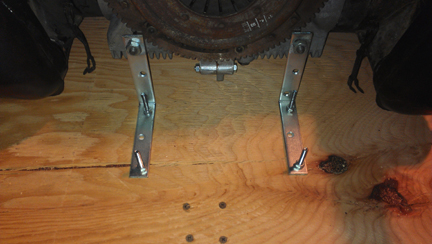
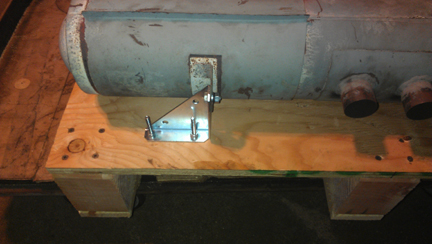
AT RIGHT: A one-off crate headed to Europe. It contains a long block. This one didn't need standoffs for forklifts because it went airfreight and not having them was an advantage! We delivered this one directly to the airline at SFO.
Strange as it might seem, shipping companies charge a premium for non-business end-points, on either source or destination. For this reason, it's vital that both ends be a "business" in order to ensure a good price. In addition, if there's not a forklift available at both ends, they also charge more, so the best price is when both have businesses with forklifts. We, of course, are a business with forklift. If your end isn't a business with a forklift but have a business you can have send or receive for you, do that, and so much the better if they have a forklift. We've seen some residential deliveries in the USA be charged nearly $1000 for the total shipping whereas a delivery to a business in the same city priced around $400, so make no assumptions about how it will play out for you and play the shipper's game.
If you have us find the vendor, once quoted, it'll be firm unless some of the terms are not properly accepted, which may include letting the driver use his lift-gate and pallet jack when your forklift was sitting right there. We strongly prefer that our customers have their own relationships with the shipper (and insurance company) because we're truly not liable for this stage of the business, but if you ask us, we'll act as your agent on these matters. ... Remember, we're car people, not shipping agents!
AT RIGHT: Another one-off headed to Europe. This one went by ocean-freight but first via our shipping it to a consolidator in the LA area and so needed the skids.
Insurance is the most often overlooked aspect of shipping! We've had engines shipped by us (or to us) get lost or damaged in transit and as unfortunate as that is, it's not our fault. So, we're very keen on recommending to every customer who has an engine shipped to please buy insurance! It's not dirt cheap, but not crazy either. And, pricing often depends on what shipping carrier you choose. As of the summer of 2017, our favorite shipper's insurance costs $83 for $5000 of coverage and $95.37 for $12,000. Don't let yourself down by not buying insurance! And certainly don't blame us if you don't!
Here are a few links to engines we've built that have been shipped. Scroll to the bottom of each to see the shipping details. This group was selected mostly for the variety. (Look to the images below for more examples.) The bottom image below shows how to attach the pulley-side when you don't have a muffler to attach to.
BELOW: 1963 production SC engine in turn-key form, in reusable crate with extra parts enclosed.
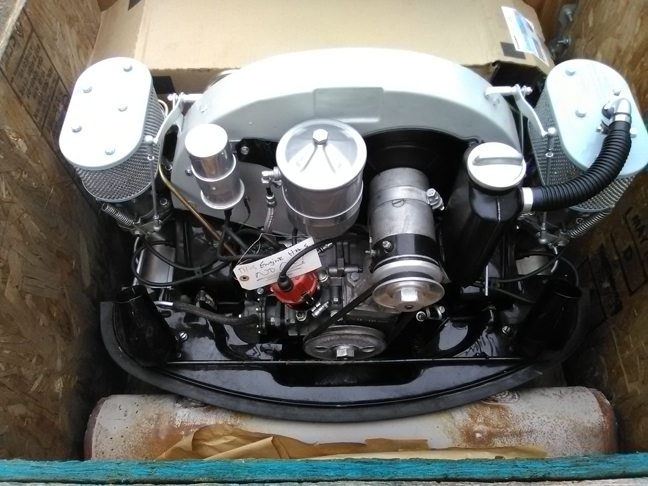
BELOW: Here, a turn-key normal with after-market exhaust is crated. It has the same bolting down at the flywheel end, but the rear is different. Note how there's a rear attachment to the case on the left lower corner of the timing cover! This was done becasue the exhaust didn't have a good spot on it. Shortblocks and long-blocks can also be done this way - any time there's not a stock muffler to attach to.
